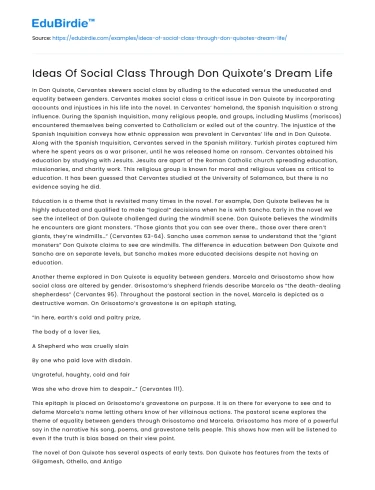In Don Quixote, Cervantes skewers social class by alluding to the educated versus the uneducated and equality between genders. Cervantes makes social class a critical issue in Don Quixote by incorporating accounts and injustices in his life into the novel. In Cervantes’ homeland, the Spanish Inquisition a strong influence. During the Spanish Inquisition, many religious people, and groups, including Muslims (moriscos) encountered themselves being converted to Catholicism or exiled out of the country. The injustice of the Spanish Inquisition conveys how ethnic oppression was prevalent in Cervantes’ life and in Don Quixote. Along with the Spanish Inquisition, Cervantes served in the Spanish military. Turkish pirates captured him where he spent years as a war prisoner, until he was released home on ransom. Cervantes obtained his education by studying with Jesuits. Jesuits are apart of the Roman Catholic church spreading education, missionaries, and charity work. This religious group is known for moral and religious values as critical to education. It has been guessed that Cervantes studied at the University of Salamanca, but there is no evidence saying he did.
Education is a theme that is revisited many times in the novel. For example, Don Quixote believes he is highly educated and qualified to make “logical” decisions when he is with Sancho. Early in the novel we see the intellect of Don Quixote challenged during the windmill scene. Don Quixote believes the windmills he encounters are giant monsters. “Those giants that you can see over there… those over there aren’t giants, they’re windmills…” (Cervantes 63-64). Sancho uses common sense to understand that the “giant monsters” Don Quixote claims to see are windmills. The difference in education between Don Quixote and Sancho are on separate levels, but Sancho makes more educated decisions despite not having an education.
Another theme explored in Don Quixote is equality between genders. Marcela and Grisostomo show how social class are altered by gender. Grisostomo’s shepherd friends describe Marcela as “the death-dealing shepherdess” (Cervantes 95). Throughout the pastoral section in the novel, Marcela is depicted as a destructive woman. On Grisostomo’s gravestone is an epitaph stating,
“In here, earth’s cold and paltry prize,
The body of a lover lies,
A Shepherd who was cruelly slain
By one who paid love with disdain.
Ungrateful, haughty, cold and fair
Was she who drove him to despair…” (Cervantes 111).
This epitaph is placed on Grisostomo’s gravestone on purpose. It is on there for everyone to see and to defame Marcela’s name letting others know of her villainous actions. The pastoral scene explores the theme of equality between genders through Grisostomo and Marcela. Grisostomo has more of a powerful say in the narrative his song, poems, and gravestone tells people. This shows how men will be listened to even if the truth is bias based on their view point.
The novel of Don Quixote has several aspects of early texts. Don Quixote has features from the texts of Gilgamesh, Othello, and Antigone. Don Quixote has a journey for a goal, to maintain status quo, and justice for those without a voice. Cervantes had written plays and novels showing that he had some sort of access to old Greek plays. Cervantes understood how Greek plays told stories about everyday life, what matters to a person, and the concerns of people. There is no information claiming that Cervantes studied Sophocles text Antigone, but there is an influence from the text. In the text of Antigone, Antigone is a confident, brave, and bold protagonist who breaks the stereotype of her being a common woman. Marcela has the same qualities of Antigone, displaying them when telling her side of the story to everyone. Cervantes took the theme of what matters to a person and expressed that through Marcela. Cervantes presents these ideas of social class through Don Quixote’s dream life, allowing the reader to synthesize how social class is still relevant in today’s time.






 Stuck on your essay?
Stuck on your essay?

